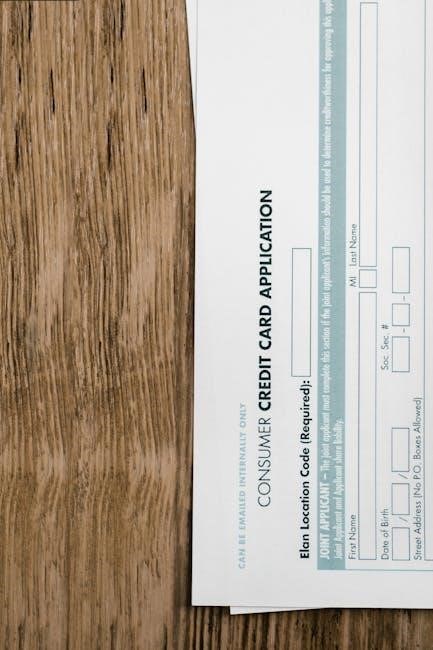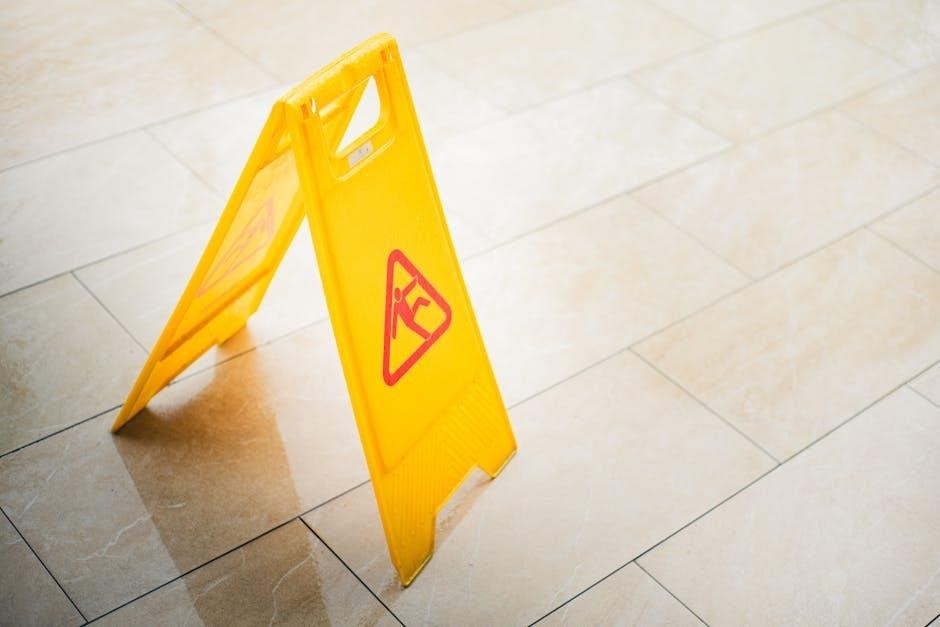A Certificate of Liability Insurance (COI) confirms your business has liability coverage, protecting against claims. A fillable PDF COI form offers a professional and efficient way to provide proof of insurance, ensuring compliance with industry standards and avoiding potential legal issues.
1.1 What is a Certificate of Liability Insurance (COI)?
A Certificate of Liability Insurance (COI) is a document that provides proof of liability insurance coverage for a business. It outlines the types of liability insurance a company holds, including policy details, coverage limits, and effective dates. A COI is often requested by clients, vendors, or partners to verify that a business is adequately insured, reducing potential risks. A fillable PDF COI form allows for easy customization and professional presentation, ensuring all necessary information is clearly displayed. This document is essential for demonstrating compliance and building trust in business relationships. It is not an insurance policy itself but serves as proof of coverage.
1.2 Importance of a COI for Businesses
A Certificate of Liability Insurance (COI) is crucial for businesses as it verifies insurance coverage, protecting against claims and financial losses. It is often required by clients, partners, or vendors to ensure compliance with contractual obligations. A fillable PDF COI form simplifies the process, allowing businesses to efficiently provide proof of insurance. This document helps establish credibility and trust, ensuring smooth business operations. By maintaining a COI, companies can avoid legal and financial risks associated with insufficient insurance coverage. It is a vital tool for safeguarding business interests and meeting industry standards.

Understanding the Purpose of a COI
A Certifcate of Liability Insurance (COI) serves as proof of insurance, verifying coverage details. It protects businesses against claims and ensures compliance with contractual or regulatory requirements.
2.1 Why Businesses Need a COI
A Certificate of Liability Insurance (COI) is essential for businesses to prove they have active liability coverage, protecting them against claims. It is often required for contracts, partnerships, or rental agreements. A COI ensures clients or partners that your business can cover potential damages or injuries, reducing financial risks. Without it, businesses may face legal or operational challenges. Having a COI also builds credibility and trust, demonstrating compliance with industry standards. It is a critical document for safeguarding your business interests and maintaining professional relationships;
2.2 When is a COI Typically Required?
A Certificate of Liability Insurance (COI) is typically required in various business scenarios. It is often requested when entering into contracts, partnerships, or rental agreements. Businesses may need to provide a COI before starting work on a project, especially in industries like construction or consulting. Landlords, clients, or vendors may also ask for it to ensure they are protected in case of accidents or damages. Additionally, a COI is commonly required for events, licensing, or permits. Having a fillable PDF COI form ensures you can quickly provide proof of insurance when needed, helping you meet deadlines and maintain compliance.

How to Obtain a Certificate of Liability Insurance
To obtain a Certificate of Liability Insurance, contact your insurer or broker. They can provide a fillable PDF form, ensuring a quick, error-free, and compliant process.
3.1 Requesting a COI from Your Insurer or Broker
To request a Certificate of Liability Insurance (COI), contact your insurer or broker directly. Provide details about your business, policy, and the purpose of the COI. Insurers often offer fillable PDF forms for convenience. Submitting a request via email or online portal is quick and efficient. Once processed, the COI is typically emailed, ensuring a professional and compliant document. Using a fillable PDF form streamlines the process, reducing errors and saving time. Always verify the accuracy of the information before finalizing the request. This ensures the COI meets the requirements of clients or partners.
3.2 Submitting a COI Request Online
Submitting a Certificate of Liability Insurance (COI) request online is a fast and efficient process. Many insurers and brokers offer online portals where you can upload required details and submit your request. Fillable PDF forms are often available, allowing you to enter information directly. Once submitted, the COI is typically delivered via email within hours. This method ensures accuracy, saves time, and provides a professional document. Platforms like myCOI Central also automate the process, making it easier to manage and track your COI requests. Online submission is convenient and streamlines compliance with business requirements.
3.3 Understanding the Requirements for a COI
To obtain a Certificate of Liability Insurance (COI), you must provide accurate details about your policy, including coverage types, limits, and deductibles. A fillable PDF COI form typically requires your business name, policy number, effective dates, and coverage specifics. Additional insured parties must be listed if required by contracts or agreements. Ensuring all information is complete and correct is essential for compliance. Official insurer details and policy validation are also necessary to confirm authenticity. Meeting these requirements ensures the COI is valid and provides proper proof of liability insurance for business operations. Attention to detail prevents delays and potential legal issues.
Key Elements of a COI Form
A Certificate of Liability Insurance (COI) includes policy details, coverage types, limits, deductibles, and effective/expiration dates. It also lists additional insured parties and provides insurer information for verification.
4.1 Policy Details and Coverage Information
A Certificate of Liability Insurance (COI) outlines essential policy details, including the type of liability coverage, policy numbers, and coverage limits. It specifies the effective and expiration dates of the policy, ensuring clarity on the duration of coverage. The form also lists the insured business or individual, along with the insurer’s name and contact information. This section provides a clear overview of the insurance policy, helping recipients verify the scope and validity of the coverage. Accurate policy details are crucial for confirming compliance with contractual or regulatory requirements.
4.2 Types of Liability Coverage Included
A Certificate of Liability Insurance (COI) specifies the types of liability coverage, such as general liability, professional liability, or product liability. It outlines the scope of protection for bodily injury, property damage, or advertising injury claims. The COI may also include umbrella or excess liability coverage, which provides additional protection beyond standard policy limits. This section ensures clarity on the insured’s liability protections, helping third parties understand the extent of coverage. Accurate listing of coverage types is essential for verifying compliance with contractual or legal requirements and avoiding potential disputes.
4.3 Policy Limits and Deductibles
A Certificate of Liability Insurance (COI) details the policy limits, which are the maximum amounts the insurer will pay for covered claims. It also outlines deductibles, the amounts the insured must pay before coverage applies. Policy limits are typically listed per occurrence and in aggregate, while deductibles vary by policy type. This section is critical for understanding the financial protections and obligations under the insurance agreement. Accurate representation of limits and deductibles ensures transparency for all parties involved, helping to prevent misunderstandings and ensuring compliance with contractual requirements.
4.4 Effective and Expiration Dates
The effective date and expiration date on a Certificate of Liability Insurance (COI) specify the policy’s coverage period. These dates are crucial for verifying that insurance is active during a specific project or contract. The effective date marks when coverage begins, while the expiration date signifies when it ends. Ensuring these dates align with business operations or contractual requirements is essential. This section helps prevent gaps in coverage and confirms that the insured is protected throughout the agreed-upon term. Accurate dates are vital for maintaining compliance and avoiding potential legal or financial risks.

How to Fill Out a COI Form
Filling out a Certificate of Liability Insurance (COI) form involves downloading the fillable PDF, entering business details, policy information, and coverage specifics. Ensure accuracy and compliance with requirements.
5.1 Step-by-Step Guide to Completing the Form
To complete a certificate of liability insurance form, download the fillable PDF and enter your business details, policy number, and coverage specifics. List the types of liability insurance, such as general or professional liability. Include policy limits, deductibles, and effective dates. Ensure all information matches your insurance policy. Double-check for accuracy to avoid delays. If additional insured parties are required, add their details. Once filled, review the form thoroughly before submitting it to the requesting party. Finally, save a digital copy for your records. This process ensures compliance and professionalism.
5.2 Required Information for Accuracy
To ensure accuracy, a certificate of liability insurance form must include the insured’s name, policy number, and coverage details. Specify the types of liability insurance, such as general or professional liability. Include policy limits, deductibles, and the effective and expiration dates of the policy. List any additional insured parties and their relationship to the insured. Ensure all information matches the actual insurance policy to avoid discrepancies. Double-check the form for completeness and accuracy before submission. This ensures the certificate is valid and meets the requirements of the requesting party. Accurate information is critical for legal compliance.
5.3 Common Mistakes to Avoid
When completing a certificate of liability insurance form, avoid common errors that could invalidate the document. Ensure all policy details, such as coverage types and limits, are accurate and match the actual insurance policy. Double-check the effective and expiration dates to confirm coverage is active. Avoid omitting additional insured parties or mislabeling them. Verify the certificate holder’s name and address for accuracy. Do not leave fields blank, as incomplete information may delay approval. Proofread the form carefully to avoid typos or incorrect data. Ensure the form is signed and dated by the appropriate authority to maintain its validity. Attention to detail prevents costly misunderstandings.

The Difference Between a COI and an Insurance Policy
A Certificate of Liability Insurance (COI) provides proof of liability insurance coverage. Unlike an insurance policy, it is not a contract and does not legally bind the insurer or certificate holder.
6.1 Understanding the Distinction
A Certificate of Liability Insurance (COI) is a document that summarizes the key details of an insurance policy, serving as proof of coverage. It is not the actual insurance policy but rather a compact overview. The insurance policy itself is a legally binding contract that outlines the terms, conditions, and scope of coverage. A COI does not create a legal obligation between the insurer and the certificate holder, unlike the policy. It is primarily used to provide third parties with evidence of insurance, such as clients or vendors, ensuring compliance and assurance of coverage.
6.2 Why a COI is Not a Contract
A Certificate of Liability Insurance (COI) is not a contract because it does not establish a legal obligation between the insurer and the certificate holder. It merely provides proof of insurance coverage, summarizing key policy details. The actual insurance policy is the legally binding document that outlines the terms and conditions of coverage. A COI does not create a contractual relationship; it simply serves as evidence of insurance for third parties, such as clients or vendors. This distinction is crucial, as the COI itself cannot be enforced as a contract in legal proceedings.

Benefits of Using a Fillable PDF COI Form
Using a fillable PDF COI form streamlines the process, saving time and reducing errors. It allows for professional, compliant documentation, ensuring clarity and efficiency in providing proof of insurance.
7.1 Convenience and Time-Saving
A fillable PDF COI form offers unparalleled convenience, allowing businesses to quickly complete and submit requests online. Digital tools enable instant access, eliminating manual data entry and reducing errors. Automated platforms streamline the process, saving valuable time. With a fillable form, businesses can easily input required details, such as policy numbers and coverage limits, and receive the certificate via email within hours. This efficiency ensures faster processing and reduces delays, making it ideal for businesses needing prompt verification of insurance coverage. The ability to manage requests digitally also minimizes paperwork and enhances overall workflow productivity.
7.2 Professionalism and Compliance
A fillable PDF COI form ensures professionalism by providing a clean, standardized format that clearly presents insurance details. It guarantees compliance with industry standards, as all required information is neatly organized and easily verifiable. This format helps businesses maintain a professional image while meeting legal and contractual obligations. By ensuring accuracy and completeness, a fillable COI form minimizes errors and demonstrates adherence to regulatory requirements. It also streamlines communication with clients or partners, fostering trust and reliability. This professional approach ensures that businesses can present their insurance proof confidently and efficiently.

How to Verify the Authenticity of a COI
To verify a COI’s authenticity, check for official insurer details, validate policy numbers, and ensure dates align with the coverage period. This confirms legitimacy.
8.1 Checking for Official Insurer Details
To verify a COI’s authenticity, examine the document for the insurer’s official name, address, and contact information. Ensure the policy number and expiration dates are clearly stated. Cross-reference these details with the insurer’s records or website to confirm accuracy. Additionally, verify that the insurer is licensed to operate in your state or region. Any discrepancies or missing information should be investigated by contacting the issuer directly. This step ensures the COI is legitimate and not fraudulent. Accurate details are essential for maintaining trust and compliance in business relationships. Always prioritize verification to avoid potential risks.
When verifying a COI, ensure the policy numbers match the insurer’s records. Check the effective and expiration dates to confirm coverage is active during the required period. Mismatches or expired dates render the certificate invalid. Use the insurer’s online portal or contact their support to validate the policy details. This step ensures the coverage is current and applicable, protecting all parties involved. Accurate dates and policy numbers are crucial for compliance and risk mitigation. Always double-check these elements to avoid discrepancies and potential legal issues. Validation ensures the certificate’s credibility and enforceability. Additional insured parties are individuals or entities requiring coverage under your policy. They are added to the COI to ensure their interests are protected. Additional insureds are necessary when a contract or agreement requires another party to be covered under your liability policy. This often occurs in business partnerships, rental agreements, or vendor contracts. For instance, landlords or event organizers may demand to be listed as additional insureds to ensure they are protected from potential risks. Adding them to the COI ensures compliance with contractual obligations and provides shared liability protection. This is a common requirement in many industries, as it mitigates risks for all involved parties. The COI form typically includes a section for listing additional insureds. To add an additional insured to a COI, first, identify the party requiring coverage and confirm their details. Next, complete the “Additional Insured” section on the fillable PDF form, ensuring all required information is accurate. This typically includes the party’s name, address, and specific policy details. Once filled, submit the form to your insurer for verification. The insurer will update the policy and issue a revised COI reflecting the added insured. This ensures all parties are protected under the policy, maintaining compliance and avoiding potential legal disputes. Digital tools like automated COI request platforms streamline the process, allowing businesses to efficiently manage and track certificate requests online, ensuring compliance and reducing administrative burdens. Automated COI request platforms streamline the process of obtaining and managing certificates of liability insurance. These tools allow businesses to submit requests online, often receiving certificates via email within minutes or hours. Features include digital storage, real-time tracking, and automated reminders for expiring policies. Platforms also generate fillable PDF COI forms, ensuring accuracy and compliance; By reducing manual tasks, these tools enhance efficiency and professionalism, helping businesses maintain proper insurance documentation and avoid potential legal risks associated with incomplete or outdated certificates; This modern approach simplifies COI management, making it faster and more reliable for all parties involved. Streamlining the COI process involves leveraging digital tools to enhance efficiency and reduce manual tasks. Fillable PDF COI forms eliminate the need for paper-based processes, allowing businesses to complete and submit requests quickly. Automated platforms enable instant delivery of certificates, reducing wait times and ensuring accuracy. Additionally, digital storage and real-time tracking simplify management, while pre-filled templates minimize errors. This streamlined approach not only saves time but also improves compliance, ensuring that businesses can easily provide proof of insurance when required. By adopting these tools, companies can maintain professionalism and avoid delays in securing necessary documentation. A fillable PDF COI form ensures compliance with industry standards and legal requirements, providing clear proof of liability coverage while avoiding potential legal disputes and penalties. Using a fillable PDF COI form ensures compliance with industry standards by providing clear, structured, and accurate information. These forms typically include required fields for policy numbers, coverage details, and effective dates, reducing errors. Compliance is critical as it verifies that your liability insurance meets regulatory and contractual requirements. Properly filled COI forms help avoid legal disputes and demonstrate professionalism. Always ensure the form includes official insurer details and valid policy information to maintain compliance and credibility with third parties. This adherence to standards ensures your business operations remain legally sound and trustworthy.
A Certificate of Liability Insurance (COI) serves as legal proof of insurance coverage, protecting your business from claims. It is crucial to understand that a COI is not a contract but verifies policy details. Incorrect or incomplete information can lead to legal disputes or penalties. Ensure all details, such as policy limits and dates, are accurate. A fillable PDF COI form helps maintain professionalism and compliance, reducing legal risks. Always verify the form’s authenticity with official insurer details to avoid potential legal challenges and ensure your business remains protected and compliant with all requirements. This document is essential for maintaining trust and security in professional relationships. A certificate of liability insurance form pdf fillable is a vital document ensuring proof of coverage and compliance. It safeguards businesses, streamlines processes, and maintains professional relationships. A certificate of liability insurance form pdf fillable serves as essential proof of insurance coverage, protecting businesses from claims. It outlines policy details, coverage types, and limits, ensuring compliance with industry standards. Digital tools simplify the process, allowing quick requests and professional presentation. Automating COI management enhances efficiency and accuracy, reducing errors. Understanding its purpose, requirements, and legal implications is crucial for businesses to maintain credibility and avoid risks. A fillable PDF format ensures clarity and convenience, making it a vital tool for modern business operations. A certificate of liability insurance form pdf fillable is a critical document for businesses, providing proof of coverage and protecting against potential claims. It ensures compliance with industry standards and demonstrates professionalism. The convenience of a fillable PDF format streamlines processes, saving time and reducing errors. Businesses should prioritize obtaining and managing COIs effectively to maintain credibility and avoid legal risks. By leveraging digital tools, companies can ensure accuracy and efficiency in handling COI requests, making it an indispensable tool for modern business operations and risk management strategies.8.2 Validating Policy Numbers and Dates

The Role of Additional Insured Parties
9.1 When Additional Insureds are Necessary
9.2 How to Add an Additional Insured to a COI

Digital Tools for Managing COI Requests
10.1 Automated COI Request Platforms
10.2 Streamlining the COI Process

Compliance and Legal Considerations
11.1 Ensuring Compliance with Industry Standards
11.2 Legal Implications of a COI
12.1 Summary of Key Points
12.2 Final Thoughts on the Importance of a COI